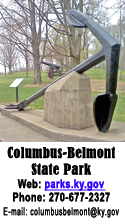|
Civil War Days up next for Kentucky’s
prominent Mississippi River facility
The “Gibraltar of the West” will be prominent again this fall with its annual event-filled Civil War Days weekend.
Battle re-enactments, living history activities, military encampments and a student “Education Day” are scheduled Friday through Sunday, Oct. 11-13, at Columbus-Belmont State Park.
Schools, scouts, groups and clubs will be welcomed as well as the general public, according to Park Manager Cindy Lynch, who is encouraging field trips throughout the grounds of a facility that initiated a key early event of the Civil War.
Activities begin Friday evening with a Ghost Walk through the park’s historic earthworks. Battles will be featured at 2 p.m. Saturday and Sunday, with a Civil War Ball scheduled Saturday evening. Worship services are on tap Sunday morning along with a memorial service at Columbus Cemetery.
Special entertainment is scheduled each day featuring Rick Revel and the 52nd Regimental String Band. All activities are free and open to the public and re-enactors with straw, wood, powder rations and meals provided to program performers.
Civil War Days is sponsored by the park, Hickman County Judge Executive/Fiscal Court and the Civil War Days Committee. Those wishing additional information and to pre-register should contact the park office (270-677-2327) or e-mail cindy.lynch@ky.gov.
Columbus-Belmont State Park was built on top of a bluff by the Civilian Conservation Corps during the 1930s. Overlooking the Mississippi River, the park has a museum featuring 1864 photographs of Union soldiers stationed at Columbus, the largest Civil War cannon in Kentucky and a six-ton sea anchor that was stretched across the Mississippi to Belmont, Mo., to block the passage of Union river vessels. The remains of infantry trenches and the Columbus fortress, Fort DeRussy/Halleck, also are featured.
The park has a conference center, a campground with rental trailers and shelter houses, plus a picnic area including playgrounds and a hiking trail.
Columbus-Belmont is a Kentucky interpretative center on the Great River Road that follows the Mississippi River. It is also a National Park Service Trail of Tears site and a National Scenic Byway.
Polk developed Columbus as major fortress
Some five months after the firing on Fort Sumter opened the Civil War, Confederate Gen. Leonidas Polk ordered the occupation of Columbus (Sept. 3, 1861). He placed some 140 cannons on the bluffs, including a giant experimental cannon that was named “Lady Polk” in honor of the general’s wife. The artillery piece was 10-feet long and weighed 15,000 pounds and could fire 128-pound conical projectiles up to three miles.
The massive anchor, buried on a bluff at Fort DeRussy, was attached to a mile-long chain of 20-pound links, supported by barges that stretched across the river from Belmont to the anchor buried inside Fort DeRussy. River mines were placed in front of the chain.
Columbus was the northern-most Confederate base along the Mississippi, protecting Memphis, Vicksburg and other key Southern locations.
Prior to occupation by Polk’s troops, the town of Columbus was a busy Mississippi River port of 1,000 people and the northern terminus of the Mobile & Ohio Railroad. Columbus sat on a plain in front of a semicircular chain of 180-foot tall bluffs. In addition to the artillery and chain, Polk, by 1862, also had established two small earthwork forts and more infantry trenches to protect the town itself. He commanded more than 17,000 soldiers.
In February 1862, Union Gen. U.S. Grant went around Columbus by capturing the much weaker Forts Henry and Donelson on the Tennessee and Cumberland Rivers. Outflanked and now useless, Columbus was abandoned by Polk in March 1862. Columbus immediately was occupied by the Union Army and Navy and became a very important military river and railroad supply depot for the rest of the war.
The occupying Union soldiers had to cope with hostile local civilians, large numbers of refugee former slaves, massive smuggling, endemic guerilla warfare and raids by Confederate Gen. Nathan Bedford Forrest. Fort DeRussy would be renamed Fort Halleck and eventually be garrisoned by 1,000 former slaves of the 4th U.S. Colored Heavy Artillery Regiment. By 1865, at least 75 percent of the Union soldiers in Western Kentucky were former slaves.
In 1918, the Mississippi River began to seriously eat away at Columbus. In 1927, the second of two record floods finally washed away 450 feet of the riverbank. The American Red Cross then moved 500 people and 166 buildings to a new Columbus City on top of the bluffs. Since then, the river has continued to slowly move eastward and has covered about half of the site of the old city.
Many of the earthen fortifications, buildings and artillery pieces were lost to bluff erosion during the heavy flooding. When flooding receded, the remains of the giant chain were exposed.
|
















